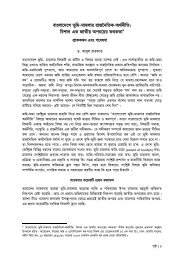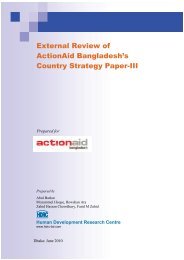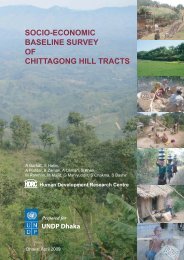08. Costing Essential Services Package An Issue Paper
08. Costing Essential Services Package An Issue Paper
08. Costing Essential Services Package An Issue Paper
You also want an ePaper? Increase the reach of your titles
YUMPU automatically turns print PDFs into web optimized ePapers that Google loves.
<strong>Costing</strong> <strong>Essential</strong> <strong>Services</strong> <strong>Package</strong>: <strong>An</strong> <strong>Issue</strong> <strong>Paper</strong> 20<br />
ring and outer rings (Balk et.al., 1988: 60). All components have been divided into five groups<br />
based on components proximity to service delivery – (1) Service delivery (per se), (2)<br />
supervision and administration, (3) data management, (4) research and international technical<br />
assistance, and (5) overhead.<br />
Based on the detailed analysis, Balk et.al.(1988) have suggested the following thought<br />
provoking issues which still appear valid:<br />
(1) attention should be given to issues of marginal cost such as, what is the marginal cost of<br />
adding health services to family planning package,<br />
(2) attempts should be made to cost the elements in the government program so that there<br />
could be more information on the extent to which particular health or family planning<br />
interventions are resource constrained, and<br />
(3) simulation exercises should be undertaken to identify the least costly approach to<br />
delivery services in rural Bangladesh.<br />
Studies conducted by Janowitz et.al. (1996a,b) and Rahman et.al. (1996) under the auspices of<br />
Population, Development and Evaluation Unit (PDEU, IMED, Ministry of Planning) purported to<br />
provide information to the government to enable it to improve the efficiency with which family<br />
planning services are provided in the government and NGO programs. The domains of the<br />
studies are limited to various dimensions of family planning only. These studies provide useful<br />
information on work pattern and service delivery costs in family planning which could be<br />
gainfully utilized in understanding unit cost and work efficiency in family planning. Janowitz and<br />
Rahman’s studies provide the following information: home service delivery costs, clinic service<br />
costs, program costs for permanent FP methods, costs of contraception per CYP, and cost<br />
impact of different services.<br />
Among various findings, those having high policy implications (in terms of work pattern and<br />
costing) were as follows:<br />
- If field workers were to increase the number of days and hours worked, that the costs of<br />
the program would remain fairly constant over the next ten years ... It is not<br />
unreasonable to expect field workers to work additional hours and days (Janowitz, et.al.<br />
(1996 a: 92).<br />
- If additional attention is paid to non-users, new users, and users having side-effects and<br />
other problems – the contraceptive use and continuation rates would increase; and such<br />
changes would therefore decrease cost per CYP (Janowitz et.al, 1996a:93).<br />
Barkat et.al.(1996) have conducted a detailed family planning cost study through participatory<br />
planning process for the MOHFW (see Barkat et.al., 1996). In order to attain the national<br />
demographic expectation, two strategies were worked out – Intender Projection and the Quality<br />
Projection with all the programmatic implications and necessary action steps for implementation.<br />
Methodological utility of the study lies in the following: projection of national family planning<br />
costs, estimation of annual total and marginal costs of all projections, calculation of average<br />
cost per birth averted, conduction of cost-benefit analysis, etc. The whole costing exercise<br />
conducted for the family planning program (which is a sub-area under the major areas of ESP)<br />
was done for sub-sub-areas (visit, follow-up, FP method-wise activities), conditions (e.g. side<br />
effects, continuation) etc. Thus, the methodology applied in the study could be of use in costing






